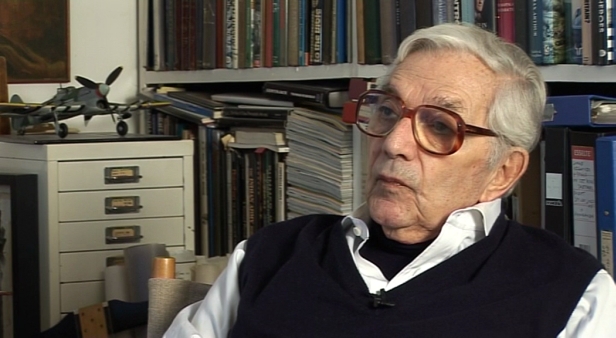NEXT STORY

Getting yellow jaundice
RELATED STORIES

NEXT STORY

Getting yellow jaundice
RELATED STORIES


|
Views | Duration | |
|---|---|---|---|
| 31. My first film: This Was a Woman | 154 | 02:35 | |
| 32. Learning art direction | 172 | 00:53 | |
| 33. My first big break: Captain Hornblower | 147 | 04:09 | |
| 34. Getting yellow jaundice | 124 | 03:48 | |
| 35. The first thing that went wrong | 113 | 04:00 | |
| 36. Bernard Voisin: the shipbuilder | 119 | 01:40 | |
| 37. Raoul Walsh: 'A tough guy' | 127 | 01:15 | |
| 38. Tom Morahan | 104 | 03:22 | |
| 39. The booming post-war smuggling trade | 117 | 02:50 | |
| 40. Becoming the reluctant 'ship man' | 109 | 04:18 |


In '49, I think... I got my first big break, which was... because I was working for Warner Brothers already, and they decided that I was the right person to go to the South of France to find... because they thought on the Tunisian shores, somewhere on the African shore, we needed a ship of the 18th century, a 1700s frigate, a 36-guns frigate, for a film they were going to make called Captain Hornblower. So that was fantastic for me, you know. I went to the South of France for Warner Brothers, and going from Nice to Marseilles and everywhere, and I got invited onto ships and… but I found a young shipbuilder at Villefranche-sur-Mer, Bernard Voisin, who was very much like me, also sort of 'press-on-regardless', and he knew more about period ships than I did, even though I had spent about two months, or maybe less, months at the Maritime Museum in Greenwich to find out what these frigates were like.
And so I had the job to really design the actual ship as opposed to the set, which we did at Denham, in the South of France at this Mr Voisin's shipyard. And we found an old hull at a place called Sète near the Spanish border which still had the sides, which the French called frégaté. You know, when you do a modern ship in section, it does this and that, but those warships of the 17th and 18th centuries, the sides came out, and then, you know…
And this ship, which they had used for cod fishing on the banks of Newfoundland, still had those sides coming out, and so I bought it for, I think, £5000 for Warner Brothers, and... it had some very old diesels in it which just about worked. And Bernard had the ship taken down... it was at Sète near the Spanish border, to Villefranche. Then we started to... making the drawings and everything, but Bernard knew a great deal about rigging and so on. But also what we did, we ballasted the hull down with about 200 tons of... I can't remember what we used, whether it was iron or something ... and started building up, so that gave us an absolute... thing. And so I spent nearly nine months in Villefranche designing the frigate for Captain Hornblower, which was a fantastic time for me, as you can imagine.
Sir Kenneth Adam (1921-2016), OBE, born Klaus Hugo Adam, was a production designer famous for his set designs for the James Bond films of the 1960s and 1970s. Initially, he trained as an architect in London, but in October 1943, he became one of only two German-born fighter pilots to fly with the RAF in wartime. He joined 609 Squadron where he flew the Hawker Typhoon fighter bomber. After the war, he entered the film industry, initially as a draughtsman on This Was a Woman. His portfolio of work includes Barry Lyndon and The Madness of King George; he won an Oscar for both films. Having a close relationship with Stanley Kubrick, he also designed the set for the iconic war room in Dr Strangelove. Sir Ken Adam was knighted by Queen Elizabeth II in 2003.
Title: My first big break: "Captain Hornblower"
Listeners: Christopher Sykes
Christopher Sykes is an independent documentary producer who has made a number of films about science and scientists for BBC TV, Channel Four, and PBS.
Tags: Captain Horatio Hornblower, 1949, Warner Brothers, France, Tunisia, Africa, Nice, Marseilles, Villefranche-sur-Mer, Maritime Museum, Greenwich, Denham, Sète, Newfoundland, Bernard Voisin
Duration: 4 minutes, 9 seconds
Date story recorded: December 2010 and January 2011
Date story went live: 14 September 2011